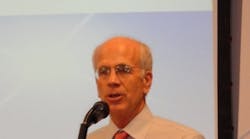Danfoss recently hosted its 17th EnVisioneering Symposium, “The Path of Renewable Energy in Buildings,” in Washington, D.C. The event convened executives in heating, ventilation and air conditioning (HVAC), government, and industry associations, to discuss the role renewable energy resources can play in the U.S. building sector, and identify the opportunities and obstacles as they pertain to HVAC manufacturers and consulting engineers.
Congressman Peter Welch (D-VT) opened the symposium with an update on energy efficiency and renewable energy policy in Congress, including the HOMES Act, a bill with strong bi-partisan support. It supports American manufacturers, creates jobs in construction and helps Americans save money on their energy bills. High-efficiency heating and cooling products represent one measure that could help homeowners achieve the 20% energy reduction, Congressman Welch noted.
Addressing the commercial building sector at a reception prior to the symposium, Congressman Charles Bass (R-NH) discussed how the Smart Energy Act could help save money and energy by improving the U.S. federal government’s energy use through private industry technologies and systems.
“Reaching our nation’s energy targets requires both energy efficiency and renewable energy resources, and renewables play a key role in driving sustainable growth.” — Robert Wilkins
Current State of Renewables
Buildings account for 70% of electricity consumption, 40% of energy use and 40% of all carbon dioxide (CO2) emissions in the U.S. Greater adoption of smart building design and technology could yield $40 to $50 billion in gross national savings by 2020. Renewable sources will come into play as city and state governments mandate zero-energy buildings, since, even though energy efficiency remains a cornerstone of the energy future, net zero buildings will not be realized on efficiency alone.
“Reaching our nation’s energy targets requires both energy efficiency and renewable energy resources, and renewables play a key role in driving sustainable growth,” said Robert Wilkins, vice president, public affairs for Danfoss North America.
Steven Lindenberg, senior advisor for renewable energy at the U.S. Department of Energy (DOE), presented an overview of renewable energies, including hydro, wind, solar, hydrogen, geothermal, next generation hydro and biomass. He also discussed current DOE research and projects designed to push renewable energy production forward in the United States. Solar energy, the fastest growing alternative energy source, grew by 109% in 2011. The barriers to renewables are being overcome and the country is now on the cusp of a new era of power generation.
Scott Hennessey, director of legislative affairs and general counsel at Solar Energies Industries Association, revealed how the current market is driving the solar industry and explained that third-party ownership is the single biggest innovation in the industry. A range of government policies and financing incentives currently support solar, but once the proper scale is achieved, the industry itself will accelerate development.
“The ability for the solar PV industry to keep investments off buildings’ balance sheets and provide energy to the building is a brilliant financing model that helps overcome the historical challenges of first-cost investments,” Hennessey said.
With the cost of solar continuing to decline, more homes and businesses are installing solar technology. This steady increase in installations has helped more Americans, including those in the HVAC industry, find jobs in the solar industry. In 2011, the industry accounted for more than 100,000 jobs, which is double the number of solar-related jobs in 2009. Yet, utilities posit that the rise of renewables will be counter-productive if they cannot be integrated into load management strategies.
Ron Domitrovic, senior project manager, energy efficiency at the Electric Power Research Institute, explained that although long-term load management can be achieved through energy efficiency, short-term load management is achieved through renewable integration and demand response, allowing end users another revenue stream – another important factor in the new energy equation. “Flexibility is the single best end-use attribute,” Domitrovic said. “The ability to adjust loads during peak conditions benefits utilities and end users. Looking at systems that respond in reasonable time and offer comfort to consumers and resources to utilities provide the best load management solution.”
Advancing to the next stage with renewables Since national legislation is not driving the transition, Michael Oldak, vice president, strategic initiatives and general counsel at the Utilities Telecom Council, suggested state regulation must drive renewable energy generation. With states driving regulations, they have the opportunity to recommend and support the renewable energy source that offers the best solution for their geographical area, given natural conditions. As a case-in-point, Friedo Sielemann, counselor for environment, energy and climate change at the German Embassy in Washington, DC, highlighted Germany’s economic growth resulting from its renewable energy strategy. Encouraged by incentives, the widespread adoption of renewable energy has caused the country’s greenhouse gas emissions to decrease by 25% since 1990, and the gross domestic product to increase by 20 percent. In addition, Germany boasts more than 380,000 green jobs.
In the final session which focused on what it will take to drive the acceptance of solar and other renewable energies, Jigar Shah, partner at Adamas Energy Investments, suggested that moving the industry forward would require investments in branding, marketing and training, along with off-balance sheet treatment with customers.
John Galyen, president of Danfoss North America, summarized the prospect of renewables by stating, “We are looking forward – to a smart grid that provides for two-way communication between utilities and end users, and building equipment that can store site-generated renewable power for use in peak periods when generation capacity is stressed and broadly can contribute to load flexibility. To accomplish that goal requires better communication between utilities, regulators and building equipment manufacturers, and legislation and regulations that best align the incentives required to create and harness the required technologies.”
Danfoss launched the EnVisioneering Symposia Series in 2006 to keep stakeholders abreast of developments in policy and industry and present a forum for on-going dialogue among industry and the policy community.








